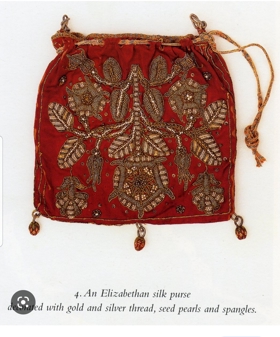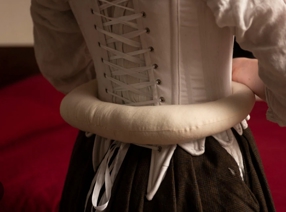Undergarments during the Renaissance
It's not often that one gets to explore the intimate details of Renaissance fashion, but thanks to this blog post, you can do just that! Here we will take a look at the history of Renaissance underwear and accessories. Believe it or not, there was more to Renaissance underclothes than just codpieces and corsets! Stay tuned for a closer look at these fascinating pieces of clothing.
 The time of the renaissance was by definition of the very word, a revolutionary world. The dark ages were ending. Manufacturing of tools made life, and also fashion, evolve into something more sophisticated. We were still a long way off from sewing machines or factory manufacturing, but easier daily living meant that people had the bandwidth to begin creating new fashion. A very good example of this is the corset. But first from the foundation up was the chemise.
The time of the renaissance was by definition of the very word, a revolutionary world. The dark ages were ending. Manufacturing of tools made life, and also fashion, evolve into something more sophisticated. We were still a long way off from sewing machines or factory manufacturing, but easier daily living meant that people had the bandwidth to begin creating new fashion. A very good example of this is the corset. But first from the foundation up was the chemise.The chemise was an undergarment of many types made in easily washable fabrics like linen and muslin. The function of it was to provide a washable barrier between the oils and sweat of the skin and expensive clothing. These garments were roughly A line but could have various necklines and sleeves. Your basic one which is perfect for reenacting or for the Faire is the one commonly thought of. The garment is voluminous, hits about knee length, with very full sleeves as well. both neckline and sleeves are secured by drawstrings at both the neck and wrist. It was commonly made in a white or beige fabric. An alternative to this was the fitted chemise. The body of this version was similar, but the sleeves are fitted just like modern ones. The neckline is also fitted to the shoulders and bust. This tends to be later period, solidly Elizabethan, but really there are few wrong answers when it comes to a chemise. It should just be comfortable against the skin and easily cleaned. Since extra layers often means sweat on even cool days, this will be paramount. Chemises are worn by both sexes.
Next, we move on to corsets. There are several types of corsets in general but the main difference between renaissance corsets and the widely known Victorian ones are general shape. While both  types are intended to shape the body and nip the waist the shape is different. Victorian corsets are very hourglass heavy in shape. Renaissance corsets are more conical in shape. The goal is the same: to whittle down the waist and sculpt the torso, but the shape is a significant difference. There are choices for the style as well. Some have straps, others do not. The bust line should rest just above the nipple; although this is a rule that can be broken if either your body shape or modesty permits it to. The corset should be worn OVER your chemise to protect it from body oils. Washing a garment with steal or whale boning is nearly as difficult as a bejeweled bodice. Many Elizabethan corsets were stiffened by a busk of wood inserted down the front of the middle of the corset in an elongated V shape. Often, they were carved with lovely patterns. Using modern steel boning I feel it's not necessary, but it can be a nice addition. And what is worn on your bottom half under your chemise? NOTHING! Historically speaking, anyway. That's right, the ladies went around in bare bottoms. This explains the critical function of the chemise to be a washable barrier between your hiney and your garb. If you think about it, it makes sense. Even the greatest of ladies need to answer the call of nature, and that is a lot of skirt to burrow into before relieving yourself. I would say most reenactors wear modern panties under their shift, even if they corset. Personally, I wear panties and bike shorts to avoid the dreaded "chub-rub". The idea or white fluffy pantaloon-style underware did not come into fashion until several hundred years later.
types are intended to shape the body and nip the waist the shape is different. Victorian corsets are very hourglass heavy in shape. Renaissance corsets are more conical in shape. The goal is the same: to whittle down the waist and sculpt the torso, but the shape is a significant difference. There are choices for the style as well. Some have straps, others do not. The bust line should rest just above the nipple; although this is a rule that can be broken if either your body shape or modesty permits it to. The corset should be worn OVER your chemise to protect it from body oils. Washing a garment with steal or whale boning is nearly as difficult as a bejeweled bodice. Many Elizabethan corsets were stiffened by a busk of wood inserted down the front of the middle of the corset in an elongated V shape. Often, they were carved with lovely patterns. Using modern steel boning I feel it's not necessary, but it can be a nice addition. And what is worn on your bottom half under your chemise? NOTHING! Historically speaking, anyway. That's right, the ladies went around in bare bottoms. This explains the critical function of the chemise to be a washable barrier between your hiney and your garb. If you think about it, it makes sense. Even the greatest of ladies need to answer the call of nature, and that is a lot of skirt to burrow into before relieving yourself. I would say most reenactors wear modern panties under their shift, even if they corset. Personally, I wear panties and bike shorts to avoid the dreaded "chub-rub". The idea or white fluffy pantaloon-style underware did not come into fashion until several hundred years later.
 types are intended to shape the body and nip the waist the shape is different. Victorian corsets are very hourglass heavy in shape. Renaissance corsets are more conical in shape. The goal is the same: to whittle down the waist and sculpt the torso, but the shape is a significant difference. There are choices for the style as well. Some have straps, others do not. The bust line should rest just above the nipple; although this is a rule that can be broken if either your body shape or modesty permits it to. The corset should be worn OVER your chemise to protect it from body oils. Washing a garment with steal or whale boning is nearly as difficult as a bejeweled bodice. Many Elizabethan corsets were stiffened by a busk of wood inserted down the front of the middle of the corset in an elongated V shape. Often, they were carved with lovely patterns. Using modern steel boning I feel it's not necessary, but it can be a nice addition. And what is worn on your bottom half under your chemise? NOTHING! Historically speaking, anyway. That's right, the ladies went around in bare bottoms. This explains the critical function of the chemise to be a washable barrier between your hiney and your garb. If you think about it, it makes sense. Even the greatest of ladies need to answer the call of nature, and that is a lot of skirt to burrow into before relieving yourself. I would say most reenactors wear modern panties under their shift, even if they corset. Personally, I wear panties and bike shorts to avoid the dreaded "chub-rub". The idea or white fluffy pantaloon-style underware did not come into fashion until several hundred years later.
types are intended to shape the body and nip the waist the shape is different. Victorian corsets are very hourglass heavy in shape. Renaissance corsets are more conical in shape. The goal is the same: to whittle down the waist and sculpt the torso, but the shape is a significant difference. There are choices for the style as well. Some have straps, others do not. The bust line should rest just above the nipple; although this is a rule that can be broken if either your body shape or modesty permits it to. The corset should be worn OVER your chemise to protect it from body oils. Washing a garment with steal or whale boning is nearly as difficult as a bejeweled bodice. Many Elizabethan corsets were stiffened by a busk of wood inserted down the front of the middle of the corset in an elongated V shape. Often, they were carved with lovely patterns. Using modern steel boning I feel it's not necessary, but it can be a nice addition. And what is worn on your bottom half under your chemise? NOTHING! Historically speaking, anyway. That's right, the ladies went around in bare bottoms. This explains the critical function of the chemise to be a washable barrier between your hiney and your garb. If you think about it, it makes sense. Even the greatest of ladies need to answer the call of nature, and that is a lot of skirt to burrow into before relieving yourself. I would say most reenactors wear modern panties under their shift, even if they corset. Personally, I wear panties and bike shorts to avoid the dreaded "chub-rub". The idea or white fluffy pantaloon-style underware did not come into fashion until several hundred years later. The next item on the list is the farthingale, or otherwise known as a hoop skirt. Most people think of fashions such as the costumes of Gone With the Wind, but much like the corset comparison that is also distinctly different. The shape of a Victorian/Civil War Era hoop is very full and round with graduated layers. The farthingale also has graduating layers; however, it is more conical in shape. The idea was to not only draw the eye to width but also to length. Some types of garb such as Italian Renaissance did not use farthingales, but nothing is stopping you from wearing them together if you like. Historical clothing should be fun and a reflection of who you are, not rigid rules.
Possibly the most amusing and interesting item worn are bum rolls. This is a crescent shaped, stuffed with batting, and tied around the waist. The idea was to make the hips look larger and waist look smaller. It also supported some of the weight of those heavy skirts. Some people can wear them and look great, but that is not me. I have a short waist and a significant curve to my hips vs waist, so I don't need that extra help. I also have a very ample behind. If you are short waisted, I would think about adding a bum roll. It can make you look even more short waisted, or "no" waisted. Knowing your body type so that you can add or leave out shapewear is critical.
 Two other items worth mentioning are ruffs and pouches. Ruffs are the large, white, accordion style cuffs and collars that are very distinctive. I will not pretend otherwise, making and even maintaining them is a part of your garb is difficult. Because of this, I have not made/do not wear one. I also have a short neck and so a neck ruff would not be flattering to me. Even the upkeep of a ruff is complicated, but they are very striking looking. Ruffs are white or gold gilded lace. They can come in many different widths. The wider the width, the higher the fashion. Your average Elizabethan housewife did not wear huge ruffs. She wouldn't be able to get much done if she did! The larger ones are typically for upper-class or nobility personas, with the gown to match. Most difficult of all are standing ruffs. These require framework support, although they could be either small or very tall. If you are up to the challenge, please do. However, there may be a lot of frustration and multiple tries involved.
Two other items worth mentioning are ruffs and pouches. Ruffs are the large, white, accordion style cuffs and collars that are very distinctive. I will not pretend otherwise, making and even maintaining them is a part of your garb is difficult. Because of this, I have not made/do not wear one. I also have a short neck and so a neck ruff would not be flattering to me. Even the upkeep of a ruff is complicated, but they are very striking looking. Ruffs are white or gold gilded lace. They can come in many different widths. The wider the width, the higher the fashion. Your average Elizabethan housewife did not wear huge ruffs. She wouldn't be able to get much done if she did! The larger ones are typically for upper-class or nobility personas, with the gown to match. Most difficult of all are standing ruffs. These require framework support, although they could be either small or very tall. If you are up to the challenge, please do. However, there may be a lot of frustration and multiple tries involved. Pouches are comparable to the modern-day wallet. The simplest ones were your basic drawstring bag that women often wore either pinned under an overskirt or at the waist if no overskirt were worn. This was a unisex item that men wore either pinned at the waist or strung on a belt. It can be made with any type of fabric from velvet to duck cloth. It can be made of either solid material or patterned. Embellishments of pearls, beads and jewels are all nice additions.
This overview of Renaissance undergarments hopefully has given you a little more insight into the variety of items and accessories that can be worn with historical clothing. While some pieces may be more challenging than others, remember that it is your choice as to what you wear and have fun with it! There are no hard and fast rules when it comes to historical reenactment, so feel free to mix and match different styles to create your own unique look.


